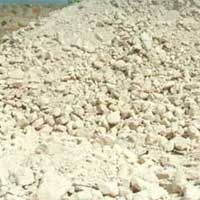Difference between revisions of "Ball Clay"
(Created page with "{{Infobox_Other_organic | image = Ball clay_1.jpg | origin = | stowage factor = | humidity and m...") |
|||
| (2 intermediate revisions by the same user not shown) | |||
| Line 1: | Line 1: | ||
{{Infobox_Other_organic | {{Infobox_Other_organic | ||
| − | | image = Ball | + | | image = Ball clay-1.jpg |
| − | | origin = | + | | origin = United States of America, England |
| − | | stowage factor = | + | | stowage factor = 1,11 m<sup>3</sup>/t (bulk) |
| − | | humidity and moisture = | + | | humidity and moisture = - |
| − | | ventilation = | + | | ventilation = - |
| − | | risk factors = | + | | risk factors = See text |
}} | }} | ||
| + | ==Description== | ||
| + | Ball clays are kaolinitic sedimentary clays, that commonly consist of 20-80% [[kaolinite]], 10-25% [[mica]], 6-65% quartz. Localized seams in the same deposit have variations in composition, including the quantity of the major minerals, accessory minerals and carbonaceous materials such as lignite. They are fine-grained and plastic in nature.<br><br> | ||
| + | Ball clays are relatively scarce deposits due to the combination of geological factors needed for their formation and preservation. They are mined in parts of the Eastern United States and from three sites in Devon and Dorset in South West England. They are commonly used in the construction of many ceramic articles, where their primary role is to either to impart plasticity or to aid rheological stability during the shaping processes.<br><br> | ||
| + | The name "ball clay" is believed to derive from the time when the clay was mined by hand. It was cut into 15 to 17-kilogram cubes and during transport the corners of the cubes became rounded off leaving "balls".<br><br> | ||
| + | The ceramic use of ball clays in Britain dates back to at least the Roman era. More recent trade began when a clay was needed to construct [[tobacco]] pipes in the 16th and 17th century. In 1771 Josiah Wedgwood signed a contract for 1400 tons a year of ball clay with Thomas Hyde of Purbeck enabling him to fire thinner walled ceramics. <br><br> | ||
| + | A clay that has good plasticity, strong bonding power, high refractoriness, and fires to a white or cream coloured product. <br><br> | ||
| + | ==Application== | ||
| + | Used as bonding and plasticizing agent or chief ingredient of whiteware, porcelains, stoneware, terra cotta, glass refractories, floor and wall tile.<br><br> | ||
| + | ==Shipment / Storage== | ||
| + | This product is liable to deteriorate into a slimy mass and cannot be trimmed. It cannot be overstowed and the proper cleaning of holds after this clay involves a great deal of labour and of time. A very high degree of hold or compartment cleanliness is required. May also be shipped in big bags.<br><br> | ||
| + | ==Risk factors== | ||
| + | * (Sea)water damage | ||
| + | * Defilement/contamination | ||
| + | |||
| + | [[Category: Products]] | ||
| + | [[Category: Minerals and rocks]] | ||
Latest revision as of 10:51, 29 October 2012
| Infobox on Ball Clay | |
|---|---|
| Example of Ball Clay |  |
| Facts | |
| Origin | United States of America, England |
| Stowage factor (in m3/t) | 1,11 m3/t (bulk) |
| Humidity / moisture | - |
| Ventilation | - |
| Risk factors | See text |
Ball Clay
Description
Ball clays are kaolinitic sedimentary clays, that commonly consist of 20-80% kaolinite, 10-25% mica, 6-65% quartz. Localized seams in the same deposit have variations in composition, including the quantity of the major minerals, accessory minerals and carbonaceous materials such as lignite. They are fine-grained and plastic in nature.
Ball clays are relatively scarce deposits due to the combination of geological factors needed for their formation and preservation. They are mined in parts of the Eastern United States and from three sites in Devon and Dorset in South West England. They are commonly used in the construction of many ceramic articles, where their primary role is to either to impart plasticity or to aid rheological stability during the shaping processes.
The name "ball clay" is believed to derive from the time when the clay was mined by hand. It was cut into 15 to 17-kilogram cubes and during transport the corners of the cubes became rounded off leaving "balls".
The ceramic use of ball clays in Britain dates back to at least the Roman era. More recent trade began when a clay was needed to construct tobacco pipes in the 16th and 17th century. In 1771 Josiah Wedgwood signed a contract for 1400 tons a year of ball clay with Thomas Hyde of Purbeck enabling him to fire thinner walled ceramics.
A clay that has good plasticity, strong bonding power, high refractoriness, and fires to a white or cream coloured product.
Application
Used as bonding and plasticizing agent or chief ingredient of whiteware, porcelains, stoneware, terra cotta, glass refractories, floor and wall tile.
Shipment / Storage
This product is liable to deteriorate into a slimy mass and cannot be trimmed. It cannot be overstowed and the proper cleaning of holds after this clay involves a great deal of labour and of time. A very high degree of hold or compartment cleanliness is required. May also be shipped in big bags.
Risk factors
- (Sea)water damage
- Defilement/contamination











